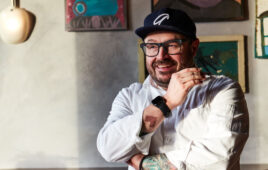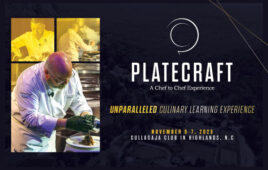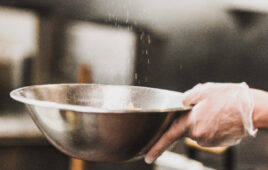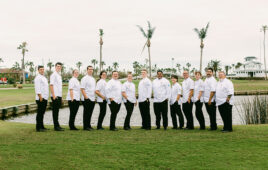At Catawba Island Club, Chef Susan Davila and her culinary staff treat members and guests to dining experiences that match the visual delights provided by the Lake Erie shoreline.
Catawba Island Club (CIC), located on a peninsula that extends into Lake Erie at Port Clinton, Ohio, midway between Cleveland and Toledo, was established in 1928 as a family outdoors club called the Catawba Cliffs Beach Club. The facility was purchased by the Stouffer family, of Stouffer Foods fame, in the fall of 1967.
CIC has one of the best-kept golfing secrets on the Great Lakes, with its newly renovated Arthur Hills-designed course. And its renowned marina, the centerpiece of the island, has 320 deepwater slips and can accommodate vessels up to 130 feet in length.
| Susan Davila CHEF PROFILE Current Position:
Previous Experience:
Education:
Professional Affiliations:
Awards:
|
At the helm in CIC’s kitchen is Chef Susan Davila, who came back to her native Ohio from Nebraska in 2002. Along with her team of culinarians, Chef Susan has been dazzling the CIC membership and their guests ever since, even while posting some pretty hefty cover-count numbers that can sometimes run upwards of 400 on summer evenings.
Chef Susan was nice enough to take time out during what is her busiest time of the year to share some of the keys to her success over the last decade at CIC.
Q: Chef, when you told me CIC will have 32 weddings this year, my first thought was, just how many weekends can you have in prime season on Lake Erie to fit all of that in? And from a food standpoint, what can you do to try to make every one of these events a memorable experience?
A: It’s true that it can be a bit overwhelming at times with so many weddings and banquets, along with our a la carte volume. I just try to keep my philosophy the same in all areas: Buy the freshest ingredients, treat them with respect, and train the staff to keep the same standards. Of course, this is sometimes easier said than done!
Q: With such huge a la carte volume in the summer and a capital expenditure budget to adhere to, what types of things do you look at before you consider what equipment purchases to make on an annual basis?
A: At the club we depreciate our equipment, so when we need to replace anything we do our research, sometimes even requiring a trip to see the equipment first-hand, to make sure we replace it with quality. As we grow, so does our need for efficiency. A good culinary team can always make the most of what they’re given to work with. Also, at the end of a challenging night, I re-evaluate and keep notes of better ways to execute the flow of food, and add to my never-ending equipment ‘wish list.’

Chef Davila (center) and her core staff take time to brainstorm each offseason for fresh ideas that can be featured during each new event-filled season at CIC.
Q: You have a dozen or so key staff that you employ year-round. I am fortunate to have that same situation at my club, which helps to create a stable environment and reduces the risk of losing good people and having to start from scratch. What strategies do you use as you prepare for each year to enhance that core group for your peak season?
A: I try to cater to the staff’s “family time” in the offseason, because I know there will be less of it in-season. For morale boosts, we take fun “foodie field trips,” and we also have brainstorming sessions in the offseason to have a running list of new feature ideas for the next summer.
I think it is great to get the core staff’s input whenever I can. I always joke with them that I am the kitchen’s “Editor,” since I am ultimately responsible for the decisions made. Christmas stockings in the kitchen are also a big hit.
Q: You’ve found a mainstay on your menu as a vegetarian option that sounds great. Every club chef is always looking for a signature option like this. How did you come up with “Zucchini Linguini with Eggplant Meatballs,” and what has the feedback been like?
A: I have to laugh when I think of the success of this dish. A couple of years ago I ran a variation of it and the members didn’t “get it.” The inspiration to try again came from wanting to use some squash blossoms out of our garden, and after a quick brainstorming session with the staff, we developed this final version. We ran it as a feature, but after so many requests we put it on the summer menu—I even had to take off an ahi tuna entrée to make room for it. I just love that our members have now embraced it as a non-traditional, vegetarian option.
Q: I heard that your club’s owner has now purchased a yacht to entertain members and their guests, and after seeing what you do at CIC, I know you won’t be satisfied with just providing boxed lunches. What ideas do you have for special catering touches to provide at this intriguing new food venue?
A: This new venture will definitely be a learning experience. We plan on training one of our year-round kitchen staff to focus on this project. With a small galley on the boat, most of the food will be prepared in the main kitchen, focusing on small bites and local ingredients. I think we will take the opportunity this offseason to do some culinary experimentation and research for this new amenity.
Q: Lastly, Chef, something you did a few years back struck me as very interesting: You enrolled in creative art classes to help you apply visual dynamics and perspective to food design. For those of us to whom art does not come naturally, how did this help you initially, and how do you continue to tap into what you learned for your daily duties at CIC?
A: I have always had an interest in art, and the classes I took were just fun. I think any time you can surround yourself with creative people, or just creative things, it can help you to develop your perspective on work, and on life in general.
Recipe for Herb-Crusted Lake Erie Walleye






